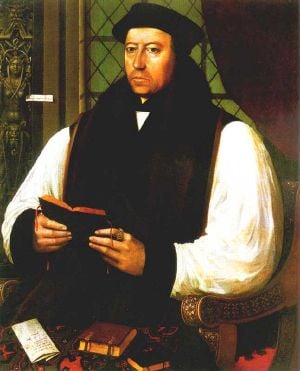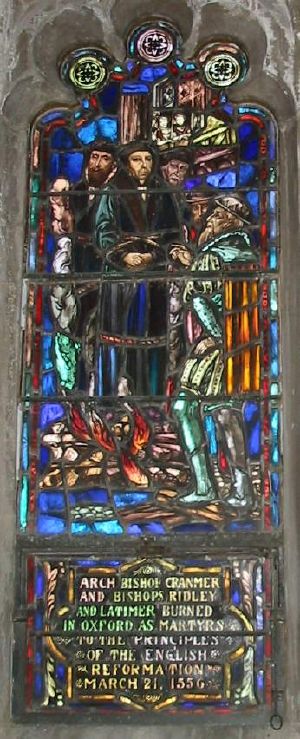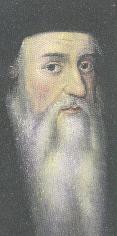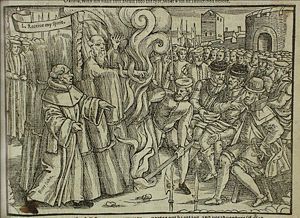Difference between revisions of "Thomas Cranmer" - New World Encyclopedia
({{Contracted}}) |
m |
||
| Line 1: | Line 1: | ||
{{Contracted}} | {{Contracted}} | ||
| − | |||
| − | |||
| − | '''Thomas Cranmer''' ( | + | [[Image:Thomas-Cranmer-ez.jpg|thumb|left|An oil painting of Thomas Cranmer by Gerlach Flicke (1545) - National Portrait Gallery (United Kingdom)|National Portrait Gallery, [[London]]]] |
| + | |||
| + | '''Thomas Cranmer''' (July 2, 1489 – March 21, 1556) was the [[Archbishop of Canterbury]] during the reigns of the English kings [[Henry VIII]] and [[Edward VI of England|Edward VI]]. He is credited with writing and compiling the first two [[Book of Common Prayer|Books of Common Prayer]] which established the basic structure of Anglican liturgy for centuries and influenced the English language through its phrases and quotations. He was one of the first Anglican [[martyr|martyrs]]; burned in 1556 for [[heresy]]. He is commemorated by the [[Church of England]] on March 21. While the English Reformation was mainly driven by political considerations, not least of all the King's desire to obtain a divorce, Cranmer's support for Henry's break with Rome was theologically motivated. He led the newly independent Church towards a reformist and Protestant self-understanding that resembled Luther's, that drew on Calvinism but which can not be wholly identified with either. While his name as a reformer is less well kmown than Luther's or Calvin's he deserves to be regarded as the father of English Protestanism. The Anglican church's main stength would be inclusivism, which represents a significant contribution to Christianity. Cranmer's detailed work on a statement of faith for the Church of England remains the offical basis of Anglican doctrine [http://www.victorianweb.org/religion/39articles.html]. | ||
==Early years ([[1489]]–[[1533]])== | ==Early years ([[1489]]–[[1533]])== | ||
Revision as of 20:19, 19 June 2006

Thomas Cranmer (July 2, 1489 – March 21, 1556) was the Archbishop of Canterbury during the reigns of the English kings Henry VIII and Edward VI. He is credited with writing and compiling the first two Books of Common Prayer which established the basic structure of Anglican liturgy for centuries and influenced the English language through its phrases and quotations. He was one of the first Anglican martyrs; burned in 1556 for heresy. He is commemorated by the Church of England on March 21. While the English Reformation was mainly driven by political considerations, not least of all the King's desire to obtain a divorce, Cranmer's support for Henry's break with Rome was theologically motivated. He led the newly independent Church towards a reformist and Protestant self-understanding that resembled Luther's, that drew on Calvinism but which can not be wholly identified with either. While his name as a reformer is less well kmown than Luther's or Calvin's he deserves to be regarded as the father of English Protestanism. The Anglican church's main stength would be inclusivism, which represents a significant contribution to Christianity. Cranmer's detailed work on a statement of faith for the Church of England remains the offical basis of Anglican doctrine [1].
Early years (1489–1533)
Cranmer was born in 1489 in Aslacton, now Aslockton, near Nottingham. His parents Thomas and Agnes Cranmer were from the lesser gentry and had only enough wealth and land to support their eldest son upon their death. Due to this lack of land the scholarly Thomas and his younger brother joined the church.
In 1510, Cranmer was given a fellowship at Jesus College, Cambridge. In 1515, while still at Cambridge he married Joan, the niece of the landlady of the nearby Dolphin Tavern; this led to his expulsion from the college due to the rule that fellows were to remain celibate. In 1519, Joan Cranmer died during childbirth; this allowed him to be re-accepted into the college. He was known as a dedicated student and was noted for his interest in unorthodox philosophy. He became a doctor of divinity in 1523.
A plague forced Cranmer to leave Cambridge for Essex. Here he came to the attention of Henry VIII, who was staying nearby. The King and his councillors found Cranmer a willing advocate for Henry's desired annulment from Catherine of Aragon and he became involved with the case as a researcher. He and Foxe compiled the Collectanea Satis Copiosa (the sufficiently abundant collection) in 1530, giving legal and historical precedent of cases such as Henry's, allowing the King to build an academic case to break with Rome. Cranmer was sent as part of the embassy to Rome in 1530, and in 1532 he became ambassador to the Holy Roman Emperor Charles V.
Cranmer met his second wife Margarete, relative by marriage of the Lutheran scholar Andreas Osiander, while spending the summer of 1532 in Nuremberg.
Archbishop under Henry VIII (1533–1547)

By January 1533 Henry found out that Anne Boleyn, the woman Henry wanted as his wife, was pregnant. This added urgency to the matter of the King's annulment and they were married in secret by the end of the month.
On March 30, 1533, Cranmer was appointed Archbishop of Canterbury after the death of Warham. Cranmer was chosen as Henry believed that he would support his policies and find solutions to his problems. This appointment by Henry, despite the consent of the Pope, shows that he had given up the hope of getting consent for an annulment from Rome.
Cranmer brought his German wife Margarete with him when he became Archbishop but kept her presence quiet so as not to be seen breaking the rules on clerical celibacy.
In May, Cranmer declared the marriage of Henry to Catherine of Aragon void and Anne Boleyn his lawful wife. In doing this, Cranmer went directly against the Pope's command. In September, Anne gave birth to Henry's second daughter Princess Elizabeth. Cranmer was the godfather.
Under Henry, Cranmer was able to push through the reforms that led gradually to the reform of the Church of England. This included writing the 10 Articles, which stated the reforms but also showed a politeness that Cranmer possessed because he didn't want to offend anyone. For example he didn't say that transubstantiation was incorrect, but that there was a possibility that it might be.
In 1538, he condemned the views of John Lambert when he denied transubstantiation. Lambert was burnt at the stake, but Cranmer later came to adopt his views.
Cranmer also opposed Henry VIII's 6 Articles, which reaffirmed clerical celibacy.
At the time of the Dissolution of the Monasteries Cranmer was given various former church properties, such as the former Cluniac Nunnery at Arthington.
Cranmer greatly admired Henry and on his death declared he would not shave his beard again as a sign of mourning.
Archbishop under Edward VI (1547–1553)

On Henry's death in 1547, Cranmer became an indispensable advisor to his son and successor, Edward VI, who, as a child, had been brought up with Protestant views.
During Edward's reign, Cranmer set about the completion of his great liturgical work begun during Henry's reign. He produced an English language liturgy with a more Protestant character. The Book of Common Prayer (BCP), as it came to be known, was heavily influenced by continental theologians, such as Peter Martyr, Martin Bucer (whom he invited to England), and by Hermann of Wied (Archbishop of Cologne, whose Consultatio was the source of a good number of elements of the new book). Cranmer was responsible for the first two editions of the BCP. The first edition in 1549 was comparatively conservative, though full of Cranmer's inimitable prose. The second edition in 1552 was more radical, greatly toning down the sacrificial element in the eucharist, removing most prayers for the dead, and removing many ceremonies from the common (as in commonly used) book. The current official BCP of the Church of England was produced in 1662.[2]
Cranmer also encouraged the destruction of images. He described these latter activities as 'jolly musters'.
Concerned about the need for good preaching and the lack of literate clergy he compiled and wrote the first Book of Homilies,[3] as well as the 42 Articles that summarise Anglican doctrine. These, in general, led the Church of England in a more Protestant direction. The 39 Articles, which were based on the 42 Articles and adopted during the reign of Elizabeth I, are still recognised as part of the Anglican heritage to which clergy in some of the national churches in the Anglican Communion vow to support.
Final years (1553–1556)
Edward VI died in 1553, to be succeeded by his half-sister, Mary I. Mary was the daughter of Henry’s first wife (Catherine of Aragon), a Spanish princess, and was brought up in the Roman Catholic faith. In line with her Catholic beliefs, she began the process of counter-reformation.
On February 14, 1556 Cranmer, as a Protestant, was removed from office, imprisoned and charged with treason. Cranmer had, after all, been responsible for the removal of Mary’s mother Catherine of Aragon. He was tried and sentenced, but the Queen spared his life. However, he was subsequently tried for heresy and, being found guilty, made several recantations, as he said later, in order to avoid execution. Despite this, which should have absolved him under Mary’s own Heresy Act, Cranmer was sentenced to death by burning. Mary had previously spared him and he had been reluctant to accede to the determination of Northumberland, Edward’s advisor to have Lady Jane Grey made Queen in her stead although he eventually agreed to the proclamation.
According to John Foxe, on 21st March 1556, Cranmer was brought in procession to St. Mary’s Church in Oxford where he was to make a public statement affirming his recantation. Instead, Cranmer withdrew his recantation and denounced Catholic doctrine and the Pope from the pulpit, reportedly stating, "And as for the Pope, I refuse him, as Christ's enemy and Antichrist, with all his false doctrine." After this Cranmer was taken to be burned at the stake.
- Then was an iron chain tied about Cranmer and fire set unto him. When the wood was kindled and the fire began to burn near him, he stretched forth his right hand, which had signed his recantation, into the flames, and there held it so the people might see it burnt to a coal before his body was touched. In short, he was so patient and constant in the midst of his tortures, that he seemed to move no more than the stake to which he was bound; his eyes were lifted up to heaven, and often he said, so long as his voice would suffer him, "this unworthy right hand!" and often using the words of Stephen, "Lord Jesus, receive my spirit," till the fury of the flames putting him to silence, he gave up the ghost. (The Book of Act and Monuments, Book of Martyrs, by John Foxe – 1563)
Bishops Ridley and Latimer had earlier been burned at this place on October 16, 1555. These three martyrdoms in Oxford are commemorated with the Victorian Martyrs' Memorial.
| Preceded by: William Warham |
Archbishop of Canterbury 1533–1556 |
Succeeded by: Reginald Cardinal Pole |
See also
- Religion in the United Kingdom
- Protestant Reformation
- Clerical celibacy
- Pope Clement VII
- Book of Common Prayer
- Oxford Martyrs
Further reading
- Diarmaid MacCulloch, Thomas Cranmer: A Life (1996)
External links
- Thomas Cranmer and The Book of Common Prayer
- BBC article
- The Book of Common Prayer (Church of England)
- The Book of Common Prayer (Catholic Encyclopaedia)
de:Thomas Cranmer fr:Thomas Cranmer nl:Thomas Cranmer ja:トマス・クランマー no:Thomas Cranmer sv:Thomas Cranmer
Credits
New World Encyclopedia writers and editors rewrote and completed the Wikipedia article in accordance with New World Encyclopedia standards. This article abides by terms of the Creative Commons CC-by-sa 3.0 License (CC-by-sa), which may be used and disseminated with proper attribution. Credit is due under the terms of this license that can reference both the New World Encyclopedia contributors and the selfless volunteer contributors of the Wikimedia Foundation. To cite this article click here for a list of acceptable citing formats.The history of earlier contributions by wikipedians is accessible to researchers here:
The history of this article since it was imported to New World Encyclopedia:
Note: Some restrictions may apply to use of individual images which are separately licensed.
